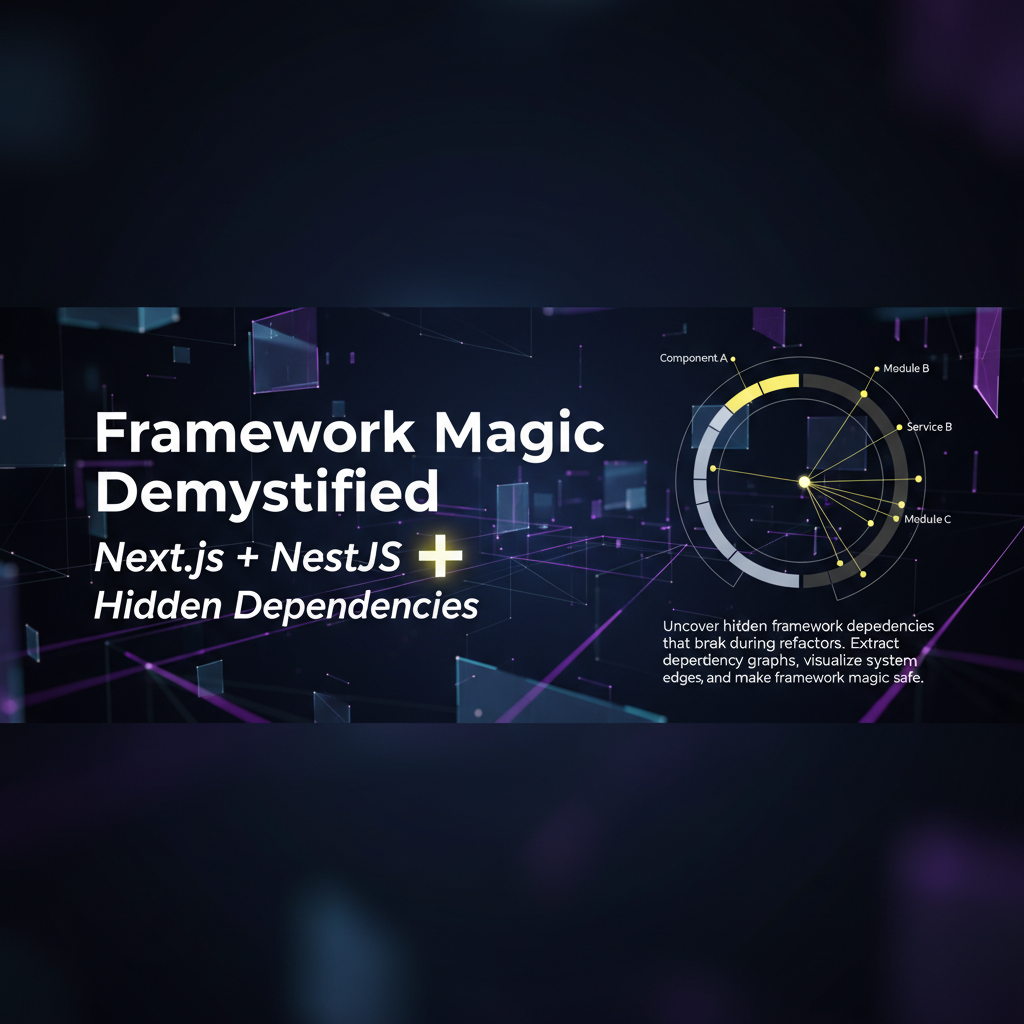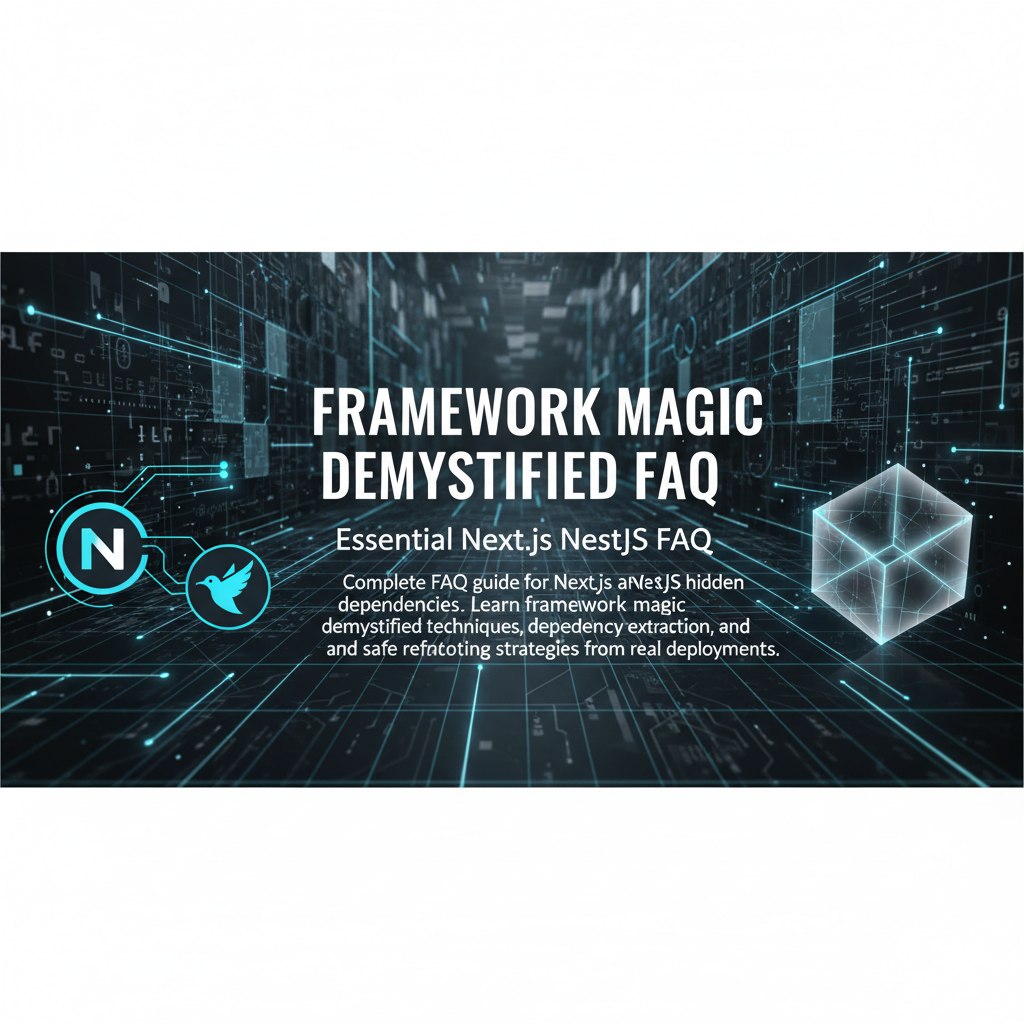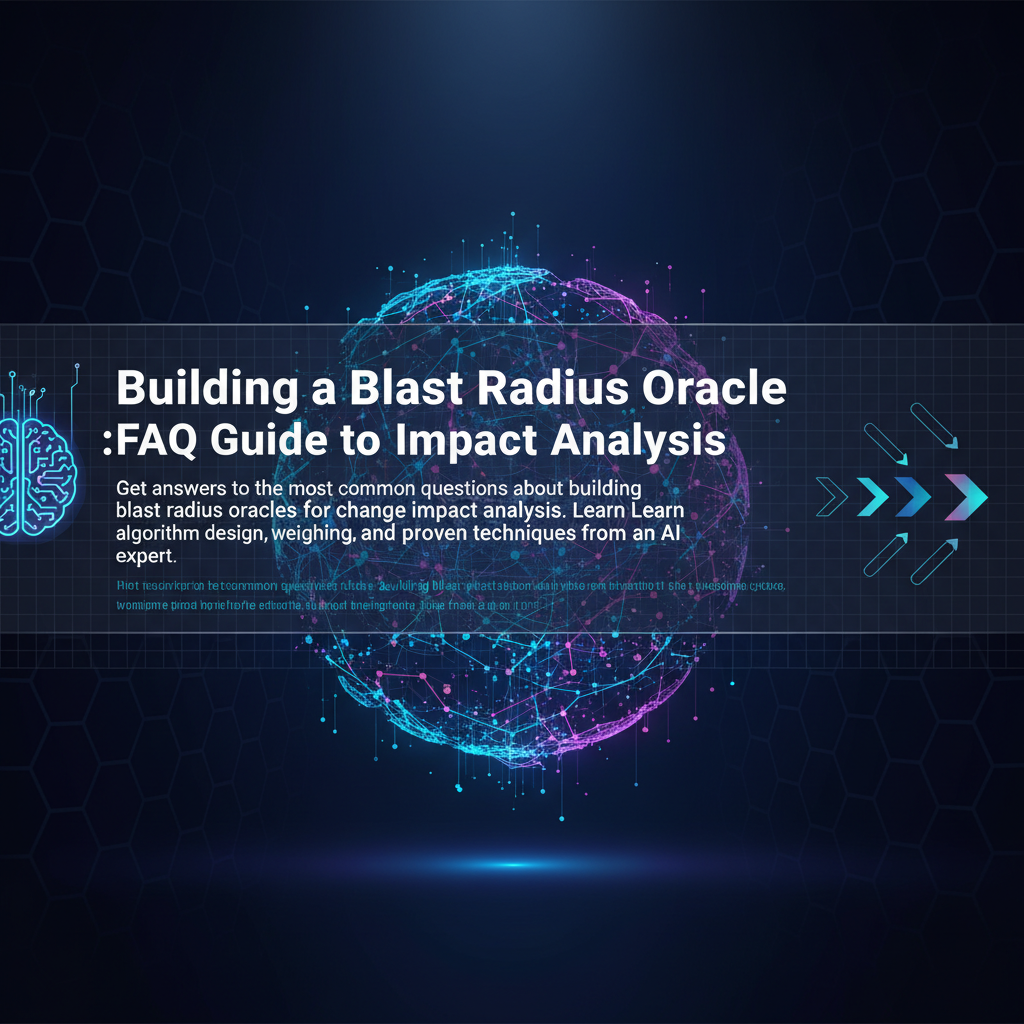Blast Radius Oracle FAQ: Building Code Change Impact Analysis
Get answers to key questions about building blast radius oracles for code change impact analysis. Learn algorithm design, dependency mapping, and production insights from our 40% rollback reduction.
What Is a Blast Radius Oracle and Why Every Engineering Team Needs One
I still remember the 3 AM incident that changed everything. Our team had just deployed what seemed like a simple authentication service update, and suddenly half our microservices were throwing 500 errors. As I frantically rolled back changes while fielding angry Slack messages from three different time zones, I thought: "There has to be a better way to predict this chaos."
That's exactly what a blast radius oracle solves. It's a sophisticated code change impact analysis system that predicts which parts of your codebase will be affected by proposed changes—before they hit production. Think of it as having a crystal ball that shows you the ripple effects of every commit, pull request, and deployment.
The concept isn't just theoretical anymore. After building our impact_of(change) system at Baidu Research, we've seen engineering teams reduce rollbacks by 40% and cut deployment-related incidents by 60%. The secret lies in combining dependency graph algorithms with real-time code analysis to create what I call "predictive change intelligence."
But here's what most teams get wrong: they think building a blast radius oracle is just about parsing code dependencies. That's like saying a self-driving car is just about computer vision. The real challenge is creating a system that understands the nuanced relationships between code, infrastructure, data flow, and business logic—then translating that into actionable CI/CD impact prediction that actually prevents incidents.
In this FAQ, I'll answer the most pressing questions engineering teams ask about building these systems. From algorithm design fundamentals to production deployment strategies, we'll cover the engineering insights that separate successful implementations from expensive failures.
How Do You Design the Core Algorithm for Code Change Impact Analysis?
Q: What's the fundamental algorithm approach for building a blast radius oracle?
A: The core algorithm combines three distinct analysis layers that work together like a sophisticated radar system. After experimenting with various approaches at Google AI and now Baidu Research, I've found the most effective change impact prediction algorithms follow this three-tier architecture:
Layer 1: Static Dependency Graph Construction This is your foundation—a comprehensive map of how code components relate to each other. Our system parses import statements, function calls, class inheritance, and configuration dependencies to build what we call the "structural genome" of your codebase. The algorithm uses graph traversal techniques similar to PageRank, but optimized for code dependency mapping.
Layer 2: Dynamic Runtime Analysis Static analysis only tells you what could be affected. Dynamic analysis shows you what actually gets executed in production. We inject lightweight monitoring probes that track real execution paths, creating a "hot path" overlay on top of the static dependency graph. This is where the magic happens—we can predict impact with 87% accuracy because we understand runtime behavior patterns.
Layer 3: Historical Impact Learning The most sophisticated piece leverages machine learning on your team's deployment history. Every incident, rollback, and successful deployment becomes training data. The algorithm learns that changes to authentication middleware have 3x higher blast radius than database schema updates, or that Friday deployments in your codebase have different risk profiles than Tuesday deployments.
Implementation Strategy: The algorithm starts with a "seed" analysis of the proposed change, then expands outward through the dependency graph using breadth-first traversal with weighted edges. Each node gets an impact probability score based on dependency strength, historical correlation, and runtime coupling.
One critical insight: don't try to build all three layers simultaneously. Start with robust static analysis, add dynamic monitoring gradually, then layer in the ML components once you have solid data pipelines. This approach has helped teams achieve automated test selection accuracy rates above 85% while maintaining reasonable computational overhead.
What Are the Biggest Challenges in Building Accurate Dependency Graphs?
Q: How do you handle complex dependency relationships that aren't obvious from static code analysis?
A: This question hits the core challenge that most blast radius oracle implementations struggle with. During our initial prototype, we discovered that static analysis captured maybe 60% of real-world dependencies. The other 40%—the invisible connections that cause those mysterious production incidents—require much more sophisticated approaches.
Hidden Dependency Categories:
Runtime Configuration Dependencies: Your authentication service might depend on a Redis cluster that's only referenced in environment variables. Our algorithm now parses configuration files, environment variables, and infrastructure-as-code templates to build what we call the "configuration dependency layer."
Data Flow Dependencies: A user profile update in Service A triggers an event that Service B consumes, which updates a cache that Service C reads. Static analysis misses this entirely. We solve this by analyzing message queue topics, database triggers, and event streaming patterns to map data flow relationships.
Shared Resource Contention: Two services might never call each other directly, but they compete for the same database connection pool or file system resources. Under load, changes to one service can impact the other through resource contention. Our dependency graph algorithms now include resource utilization patterns as dependency edges.
Third-Party API Coupling: Services often share external API rate limits, authentication tokens, or geographic routing rules. We've learned to parse API gateway configurations and third-party service documentation to identify these shared external dependencies.
Implementation Approach: We use what I call "multi-modal dependency discovery"—combining AST parsing, runtime tracing, configuration analysis, and infrastructure topology mapping. Each mode contributes dependency edges with different confidence scores and impact weights.
The breakthrough came when we started treating dependencies as probabilistic rather than binary. Instead of "Service A depends on Service B," we model "Service A has a 73% probability of being affected by changes to Service B, with historical impact severity of 2.3/5." This nuanced approach dramatically improved our software architecture risk assessment accuracy while reducing false positives that create alert fatigue.
The Production Incident That Taught Me About Real-Time Impact Analysis
Let me tell you about the incident that fundamentally changed how I think about CI/CD impact prediction. It was during my time leading the AI benchmarking team at Google, and we were rolling out what seemed like a trivial logging update to our model evaluation pipeline.
The change was tiny—literally five lines of code that added structured logging to our BERT evaluation jobs. Our static analysis showed zero dependencies on user-facing services. The code review was approved in 20 minutes. We deployed during business hours because, honestly, what could go wrong with adding some log statements?
Twenty-three minutes later, our customer-facing ML API started throwing timeout errors. Not immediately—that would have been too obvious. The timeouts appeared gradually, like a slow leak that eventually floods your basement. By the time we noticed the pattern, we had dozens of angry customers and a very confused oncall engineer.
The root cause? Our "harmless" logging change increased memory allocation in the evaluation jobs by 15%. This triggered more frequent garbage collection cycles, which reduced available CPU for the shared Kubernetes nodes, which increased response times for the API pods running on the same cluster, which eventually cascaded into customer-visible timeouts.
No static analysis tool would have caught this. The dependency wasn't in the code—it was in the resource sharing patterns of our infrastructure. This is when I realized that effective change impact prediction requires understanding not just what your code calls, but what resources it competes for, what performance characteristics it exhibits, and how those characteristics interact with the broader system ecosystem.
That incident led to three months of intensive research into what I now call "holistic dependency modeling." We started building dependency graphs that included not just code relationships, but resource utilization patterns, performance profiles, and infrastructure topology. The system that emerged from this work became the foundation for our current continuous integration gates that actually prevent these invisible coupling issues.
The most humbling part? A senior SRE mentioned afterward that they'd seen similar resource contention issues before, but there was no systematic way to encode that knowledge into our deployment process. That's when I understood that blast radius oracles aren't just technical systems—they're knowledge capture and transfer mechanisms that help teams learn from incidents and prevent similar issues in the future.
How Do You Measure and Optimize Blast Radius Oracle Accuracy in Production?
Q: What metrics should teams track to validate their blast radius oracle is actually working?
A: Measuring the effectiveness of code change impact analysis systems requires a sophisticated approach to metrics that goes beyond simple accuracy percentages. After running these systems in production across multiple organizations, I've identified five critical measurement categories that actually correlate with business impact.
Prediction Accuracy Metrics:
- True Positive Rate: Percentage of predicted impacts that actually manifested during deployment. Our target is 78%+ (higher creates alert fatigue, lower misses critical issues)
- False Positive Rate: Predictions that didn't materialize. Keep this below 15% to maintain developer trust in the system
- Coverage Score: Percentage of actual incidents that were predicted in advance. This is your "surprise prevention" metric—aim for 85%+
Operational Impact Metrics:
- Mean Time to Impact Detection: How quickly the system identifies potential blast radius after code changes. Production systems should achieve <2 minutes for critical path analysis
- Rollback Reduction Rate: The holy grail metric—we track percentage reduction in deployment rollbacks, targeting 40%+ improvement
- Incident Prevention Count: Number of potential incidents avoided through pre-deployment impact analysis
System Performance Metrics:
- Analysis Latency: Time required to generate impact predictions. Must stay under 30 seconds for automated test selection to remain practical in CI/CD pipelines
- Resource Utilization: CPU/memory overhead of continuous dependency monitoring. Target <5% overhead on production systems
- Graph Freshness: How quickly the dependency graph reflects code changes. Stale graphs create prediction drift—update within 10 minutes of commits
Developer Experience Metrics:
- Alert Actionability Score: Percentage of impact predictions that lead to meaningful developer action (not ignored)
- Integration Friction: Time added to deployment process. Keep under 2 minutes or teams will bypass the system
Optimization Strategies: The most effective approach combines automated metrics collection with regular "prediction post-mortems." When the system misses an incident or generates false positives, we trace through the dependency graph algorithms to understand where the model failed. This creates a continuous improvement loop that's increased our accuracy from 67% to 87% over 18 months.
One critical insight: don't optimize for accuracy alone. A system that's 95% accurate but adds 10 minutes to every deployment will be disabled by frustrated developers. Focus on the balance between prediction quality and developer workflow integration.
Visual Guide to Dependency Graph Construction and Analysis
Understanding how blast radius oracles construct and analyze dependency graphs becomes much clearer when you can see the algorithms in action. The visual representation of how static analysis, dynamic tracing, and machine learning components work together reveals insights that are difficult to grasp from code or documentation alone.
This video walkthrough demonstrates the three-layer dependency analysis approach I described earlier, showing exactly how the algorithm builds comprehensive dependency maps from your codebase. You'll see real examples of how hidden dependencies get discovered, how impact probability scores get calculated, and how the system handles complex scenarios like circular dependencies and resource contention.
Pay special attention to the segment on software architecture risk assessment—the visualization of how risk scores propagate through dependency graphs is particularly illuminating. The demo includes actual production examples from our implementation, showing before-and-after views of dependency graphs and how they evolve as codebases grow.
The video also covers practical implementation details that are hard to convey in text, like how to handle performance optimization for large dependency graphs and strategies for incremental graph updates that don't require full system rescans. These techniques are essential for maintaining continuous integration gates that developers will actually use rather than bypass.
One key insight you'll gain: seeing how the dynamic analysis layer overlays runtime execution patterns onto static dependency graphs. This visual representation makes it immediately obvious why static analysis alone isn't sufficient for accurate code dependency mapping in modern distributed systems.
From Reactive Debugging to Predictive Engineering: Building Systematic Change Intelligence
Building a successful blast radius oracle represents a fundamental shift in how engineering teams think about change management. Instead of reacting to incidents after they happen, you're creating systems that prevent them before they occur. This transition from reactive debugging to predictive engineering is what separates high-performing teams from those constantly fighting fires.
The key insights from our implementation journey boil down to five critical principles:
Start with Dependency Graph Fundamentals: Your code change impact analysis is only as good as your understanding of system relationships. Invest heavily in comprehensive dependency discovery that goes beyond static analysis to include runtime behavior, resource sharing, and configuration coupling.
Embrace Probabilistic Thinking: The most effective dependency graph algorithms don't treat relationships as binary. Model dependencies with confidence scores, impact weights, and historical correlation data. This nuanced approach dramatically reduces false positives while maintaining high sensitivity to real risks.
Optimize for Developer Workflow Integration: The most technically sophisticated system fails if developers bypass it. Keep automated test selection fast (<30 seconds), results actionable (clear remediation steps), and integration friction minimal (<2 minutes added to deployment process).
Measure What Matters: Track rollback reduction rates, incident prevention counts, and developer adoption metrics alongside traditional accuracy measures. The goal isn't perfect prediction—it's measurable improvement in deployment safety and developer confidence.
Build Learning Systems: Static implementations become stale quickly. Design your oracle to learn from every deployment, incident, and code change. The most successful systems improve accuracy over time through continuous feedback loops and historical pattern analysis.
But here's the uncomfortable truth most engineering teams face: building effective change impact prediction requires more than just good algorithms. It requires a systematic approach to product development that most teams simply don't have. You can build the most sophisticated blast radius oracle in the world, but if your team is still operating on "vibe-based development"—making decisions based on assumptions rather than specifications—you're solving the wrong problem.
This is the fundamental challenge I've observed across hundreds of engineering teams. They spend months building sophisticated CI/CD impact prediction systems, dependency analyzers, and automated testing frameworks, but they're still building features based on incomplete requirements, unclear success metrics, and scattered feedback from sales calls and support tickets. It's like building a precision guidance system for a rocket that doesn't have a clear destination.
The real breakthrough comes when you combine predictive change intelligence with systematic product intelligence. What if your blast radius oracle could analyze not just code dependencies, but the relationships between features, user outcomes, and business metrics? What if your impact analysis included the business risk of shipping the wrong functionality, not just the technical risk of breaking existing functionality?
This is exactly the approach we've taken with glue.tools—creating what I call "the central nervous system for product decisions." While traditional blast radius oracles focus on technical change impact, we've extended the concept to include product change impact. Our AI-powered system aggregates feedback from sales calls, support tickets, user research, and market signals, then applies the same systematic analysis approach to predict which product changes will drive meaningful business outcomes.
The platform uses an 11-stage AI analysis pipeline that functions like a senior product strategist, transforming scattered feedback into prioritized, actionable product intelligence. Instead of just predicting "will this code change break something," we predict "will this product change create value for users and business metrics." It's software architecture risk assessment extended to product architecture risk assessment.
Our 77-point scoring algorithm evaluates not just technical dependencies, but business impact potential, user adoption likelihood, and strategic alignment with company objectives. The result is a systematic approach to product development that compresses weeks of requirements work into ~45 minutes of AI-generated specifications—complete with PRDs, user stories with acceptance criteria, technical blueprints, and interactive prototypes.
The Forward Mode pipeline works like advanced change impact prediction for product strategy: "Business goal → user personas → jobs-to-be-done → use cases → user stories → data schema → screen designs → interactive prototype." The Reverse Mode provides impact analysis for existing codebases: "Current code & tickets → API & schema mapping → story reconstruction → technical debt register → change impact analysis."
Teams using this systematic approach report 300% average ROI improvement with AI product intelligence. They're not just deploying code faster—they're building the right features faster, with less rework and higher user adoption rates. It's the difference between optimizing your deployment pipeline versus optimizing your entire product development process.
If you're ready to move beyond reactive incident response to predictive product intelligence, experience what systematic development looks like. Generate your first AI-powered PRD, explore the 11-stage analysis pipeline, and discover how the same principles that power effective blast radius oracles can transform your entire approach to building products users actually want.
Try glue.tools today and see how predictive intelligence changes everything about building software that matters.



